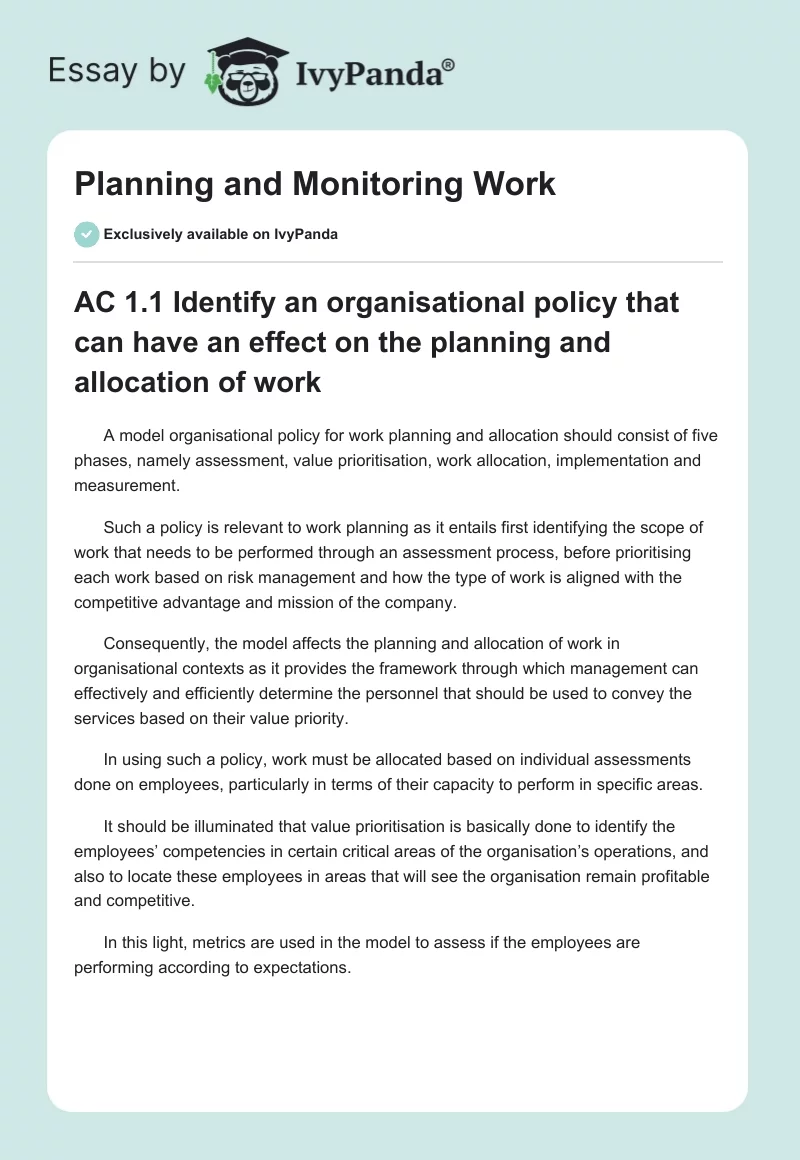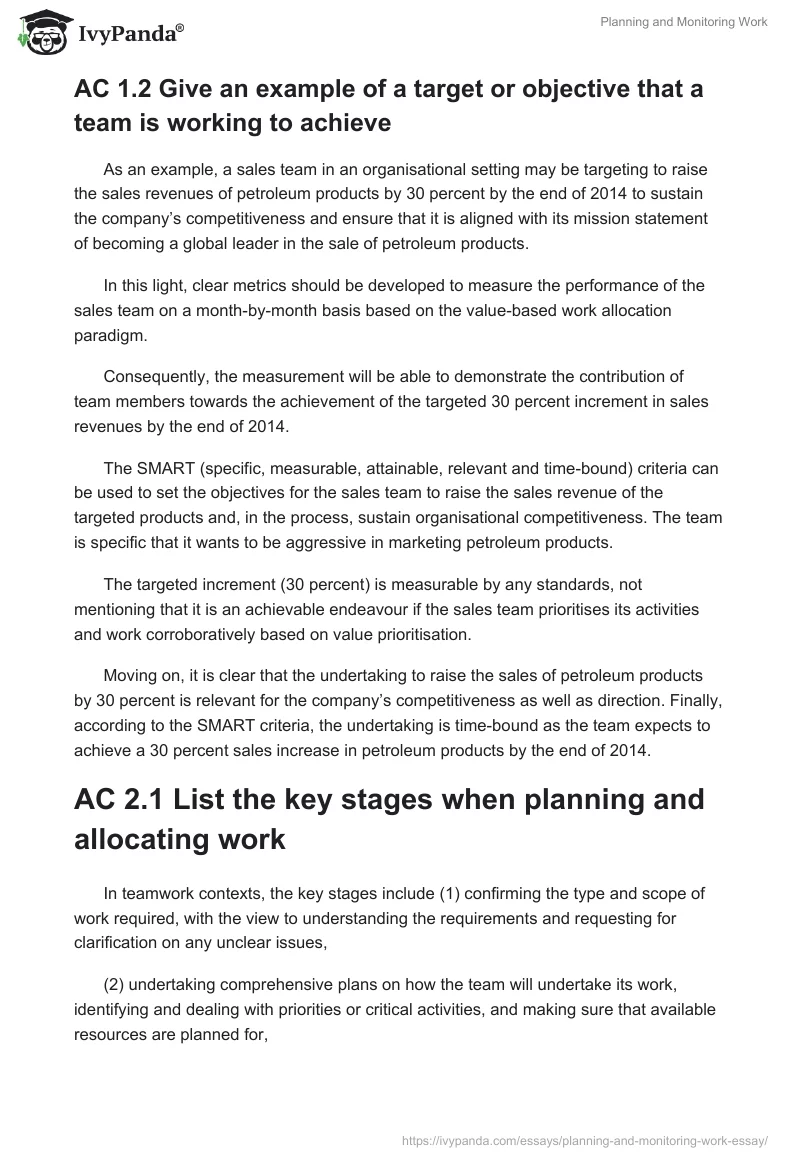AC 1.1 Identify an organisational policy that can have an effect on the planning and allocation of work
A model organisational policy for work planning and allocation should consist of five phases, namely assessment, value prioritisation, work allocation, implementation and measurement.
Such a policy is relevant to work planning as it entails first identifying the scope of work that needs to be performed through an assessment process, before prioritising each work based on risk management and how the type of work is aligned with the competitive advantage and mission of the company.
Consequently, the model affects the planning and allocation of work in organisational contexts as it provides the framework through which management can effectively and efficiently determine the personnel that should be used to convey the services based on their value priority.
In using such a policy, work must be allocated based on individual assessments done on employees, particularly in terms of their capacity to perform in specific areas.
It should be illuminated that value prioritisation is basically done to identify the employees’ competencies in certain critical areas of the organisation’s operations, and also to locate these employees in areas that will see the organisation remain profitable and competitive.
In this light, metrics are used in the model to assess if the employees are performing according to expectations.
AC 1.2 Give an example of a target or objective that a team is working to achieve
As an example, a sales team in an organisational setting may be targeting to raise the sales revenues of petroleum products by 30 percent by the end of 2014 to sustain the company’s competitiveness and ensure that it is aligned with its mission statement of becoming a global leader in the sale of petroleum products.
In this light, clear metrics should be developed to measure the performance of the sales team on a month-by-month basis based on the value-based work allocation paradigm.
Consequently, the measurement will be able to demonstrate the contribution of team members towards the achievement of the targeted 30 percent increment in sales revenues by the end of 2014.
The SMART (specific, measurable, attainable, relevant and time-bound) criteria can be used to set the objectives for the sales team to raise the sales revenue of the targeted products and, in the process, sustain organisational competitiveness. The team is specific that it wants to be aggressive in marketing petroleum products.
The targeted increment (30 percent) is measurable by any standards, not mentioning that it is an achievable endeavour if the sales team prioritises its activities and work corroboratively based on value prioritisation.
Moving on, it is clear that the undertaking to raise the sales of petroleum products by 30 percent is relevant for the company’s competitiveness as well as direction. Finally, according to the SMART criteria, the undertaking is time-bound as the team expects to achieve a 30 percent sales increase in petroleum products by the end of 2014.
AC 2.1 List the key stages when planning and allocating work
In teamwork contexts, the key stages include (1) confirming the type and scope of work required, with the view to understanding the requirements and requesting for clarification on any unclear issues,
(2) undertaking comprehensive plans on how the team will undertake its work, identifying and dealing with priorities or critical activities, and making sure that available resources are planned for,
(3) allocating work to team members based on a multiplicity of value prioritisations, including skills, prior experience, and prospect for personal and professional development,
(4) briefing team members on the nature and scope of work assigned to them, level of expected performance, as well as facilitating members to seek clarification on unclear issues and contribute in making suggestions,
(5) checking the progress and quality of work generated by team members against the expected performance and other metrics designed by relevant parties not only to assist in ensuring that the right direction is being followed, but also in providing prompt and constructive feedback,
(6) motivating members and availing the right kind of support and resources to assist in successful completion,
(7) monitoring the team for conflict, delineating the root causes of conflict when it occurs so as to deal with it effectively, identifying unacceptable performance, and agreeing on ways to improve performance,
(8) recognising successful completion of important pieces of work or work activities by team members according to the initial plan and expected performance, and
(9) using the information collected on team members’ performance to undertake a formal appraisal of performance.
AC 2.2 Describe how work is allocated to meet team objectives
Work can be allocated to team members using a methodology known as Responsibility Charting, which involves identifying the team member who is best suited to dealing with a condition or issue in a particular area using four roles that individuals assume when taking a decision, namely information provider, consultant, decision-maker and knowledge recipient or beneficiary.
To meet the team objectives, therefore, one team member may be allocated the task of identifying and providing relevant information about a particular issue or problem, while another is allocated the role of consulting on the right options based on his or her competency and prior experience.
Moving on, the team head may assume the position of the decision-maker and choose the most effective option provided by the consultant for onward communication and discussion with senior management and other team members, thus making the latter to become the recipients of the knowledge.
The Responsibility Charting process assists members to meet the set team objectives not only by encouraging them to adopt the roles they feel most comfortable with due to the ongoing consultation, hence ensuring that individuals are encouraged to assume responsibility for their roles, but also by ensuring that conflicts are successfully settled in a corroborative approach.
AC 2.3 Describe how to check that team members understand their allocated work
Team leaders not only need to allocate work to team members, but also ensure that that they have the appropriate processes and strategies to ensure that members understand their allocated work.
One way for team leaders to do this is by ensuring that members in the team (1) identify with their roles and expectations, (2) recognize the role of their teammates, with the view to ensuring that they focus on their own responsibilities and that their actions do not encroach on their teammates work-related functions, (3) comprehend how the roles interconnect in the realization of the team’s set objectives, and (4) exhibit adequate authority to harmonize activities with teammates.
AC3.1 Outline a method to monitor the team’s performance against the plan
In the context of a team in a production domain, key performance indicators (KPIs) can be employed to assess the team’s performance and success in relation to the set goals and objectives. Although these performance measurements vary from one team to the other, a list of seven common productions KPIs include
(1) count – typically refers to production sum for the entire shift or week by comparing individual worker and shift output to invoke a competitive spirit among employees,
(2) reject ratio – minimising scrap generated in production processes assists teams to meet their profitability objectives,
(3) rate – slow rates characteristically results in incapacity to meet initial plan while faster speeds may affect quality control, hence the need for operating speeds to remain consistent,
(4) target – KPIs assist to motivate team members to meet specific performance targets as indicated in the displayed target values or initial plan for output, rate and quality,
(5) takt time – entails monitoring the cycle time taken for the completion of a task to determine constraints hindering the realization of initial plan,
(6) overall personnel and equipment utilization, and
(7) downtime – reducing downtime is an easy way to increase profitability and ensure the achievement of initial performance levels according to plan.
AC 3.2 Describe an action the team leader could take to rectify underachievement against the plan
Owing to the fact that in most cases underachievement against the plan is brought about by a lack of motivation on the part of team players, the team leader should engage in motivating members. This should be done by first researching the issues surrounding the underachievement, before inviting members for a discussion on the same.
During the contact meeting, it should be the function of the leader to set clear expectations and underline the goals and objectives for performance as provided for in the initial plan.
The leader should also focus on knowing if there are any perceived challenges contributing to the underachievement so as to address them, establish an action plan and checkpoints for reviewing the action plan, provide any incentives for improvement as necessary, and also discuss with members the ramifications for continued underachievement.
Afterwards, the team leader should routinely evaluate the checkpoints to note progress and assess performance against the plan.


